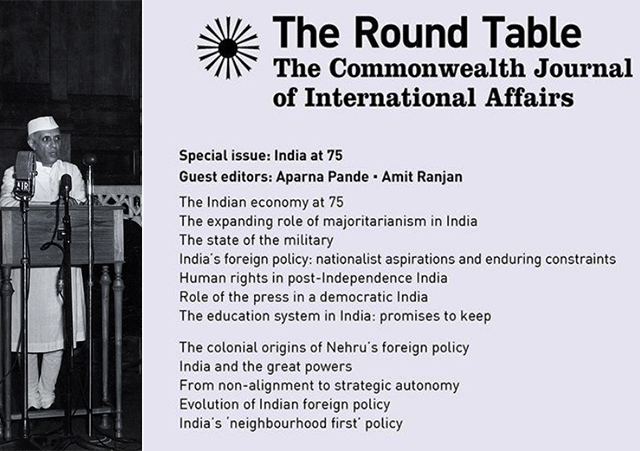 Jawaharlal Nehru was considered a chief architect of Indian foreign policy in the early years of India’s independence. [photo: World History Archive / Alamy Stock Photo]
Jawaharlal Nehru was considered a chief architect of Indian foreign policy in the early years of India’s independence. [photo: World History Archive / Alamy Stock Photo]
[This is an excerpt from an article appearing in the special edition on India at 75 of The Round Table: The Commonwealth Journal of International Affairs.]
Soon after its independence in 1947, Indian foreign policy makers had to deal with an ideologically divided world. Western (liberal-capitalist) and Eastern (communist) blocs were led by the United States of America (USA) and former Union of Soviet Socialist Republics (USSR) respectively. Instead of joining any of the two blocs, India along with many of the then newly independent colonies established the Non-Aligned Movement (NAM) in 1961, which became a voice of the developing countries at multilateral forums. The Cold War (1947-1991) based World Order crumbled with the disintegration of the former USSR in 1991. The end of the Cold War made many countries, including India, to re-think their foreign policy and adjust their economic structures. In the immediate post-Cold War years, India took political steps to improve its relationship with the USA, Western European countries, and China. In 1991, India also adopted a new economic policy based on liberalisation, privatisation and globalisation.
In the 30 years after India made a major shift in its foreign and economic policy much has changed in global politics. To secure its interests in a changed world India has deliberately, or out of compulsion, made certain adjustments in foreign policy. However, some of the basic tenets of India’s foreign policy remain unchanged, though modified from time to time to achieve the country’s interests.
The Indian economy at 75
The expanding role of majoritarianism in India
The state of the Indian military: historical role and contemporary challenges
Personality wise, the first prime minister of India, Jawaharlal Nehru, was considered a chief architect of Indian foreign policy in early years of India’s independence, and Nehruvian policies endure. However, successive prime ministers, including those who led coalition governments, have played their part in shaping Indian foreign policy. Highlighting the role of a leader and political leadership, and changes in the Indian foreign policy after Narendra Modi was elected into power in 2014, some scholars started talking about a ‘Modi Doctrine’, and how Modi’s foreign policy is ‘different’ (Chaulia, 2016; Ganguly et al., 2016). For Mohan (2015) Modi has ‘reinvigorated’ India’s foreign policy. Pant (2016, pp. 13–14) sees signs of a new dynamism and pragmatism in India’s foreign policy under Modi. At another level, Hall (2015) finds that although Modi has brought a new energy, his foreign policy objectives are similar to those pursued by Atal Bihari Vajpayee and Manmohan Singh. Ganguly (2017) observes that, although Modi has made certain departures from the past, he has not ‘fundamentally altered the orientation of India’s foreign policy’.
India’s place in America’s world under the Biden presidency: decoding the China factor
India–China relations – the present, the challenges and the future
As in the past, one of the major concerns and challenges to Indian foreign policy in present times is: how to deal with China? Political tensions between the USA and China, and growing Chinese assertiveness in South Asia have a major impact on India. The Modi years have witnessed serious political and military tensions between India and China. In 2017 Indian and Chinese soldiers were engaged in a military stand-off for 73 days at Doklam in Bhutan. More seriously, in 2020 Indian and Chinese soldiers clashed in Galwan valley in Ladakh when 20 Indian and, as acknowledged by China in 2021, four Chinese personnel lost their lives (BBC, 2021).
Amit Ranjan is a Research Fellow at the Institute of South Asian Studies, National University of Singapore.
Special editions of The Round Table Journal:
India at 75
Special edition introduction: Falkland Islands – 40 years on
COP26 special edition



